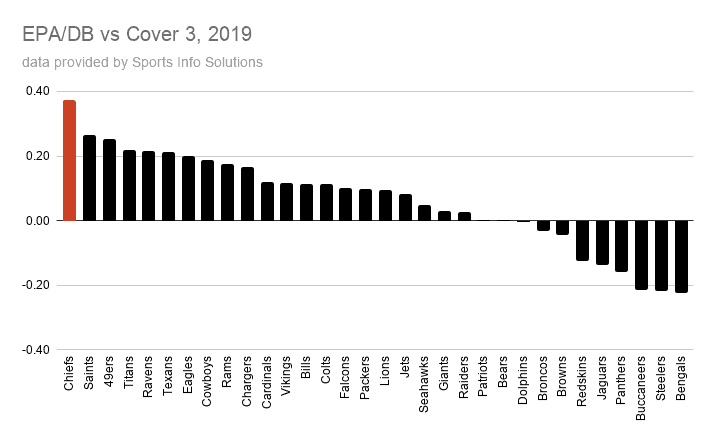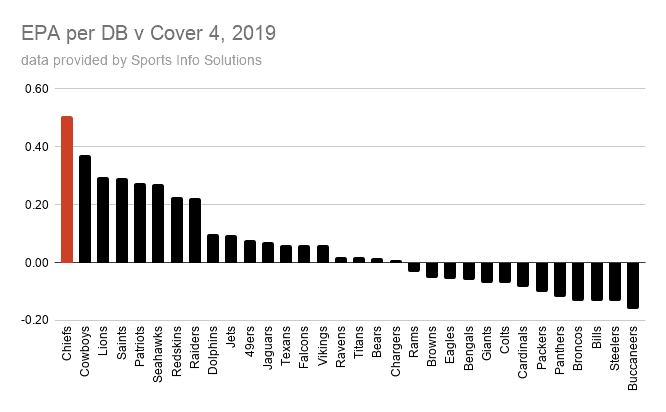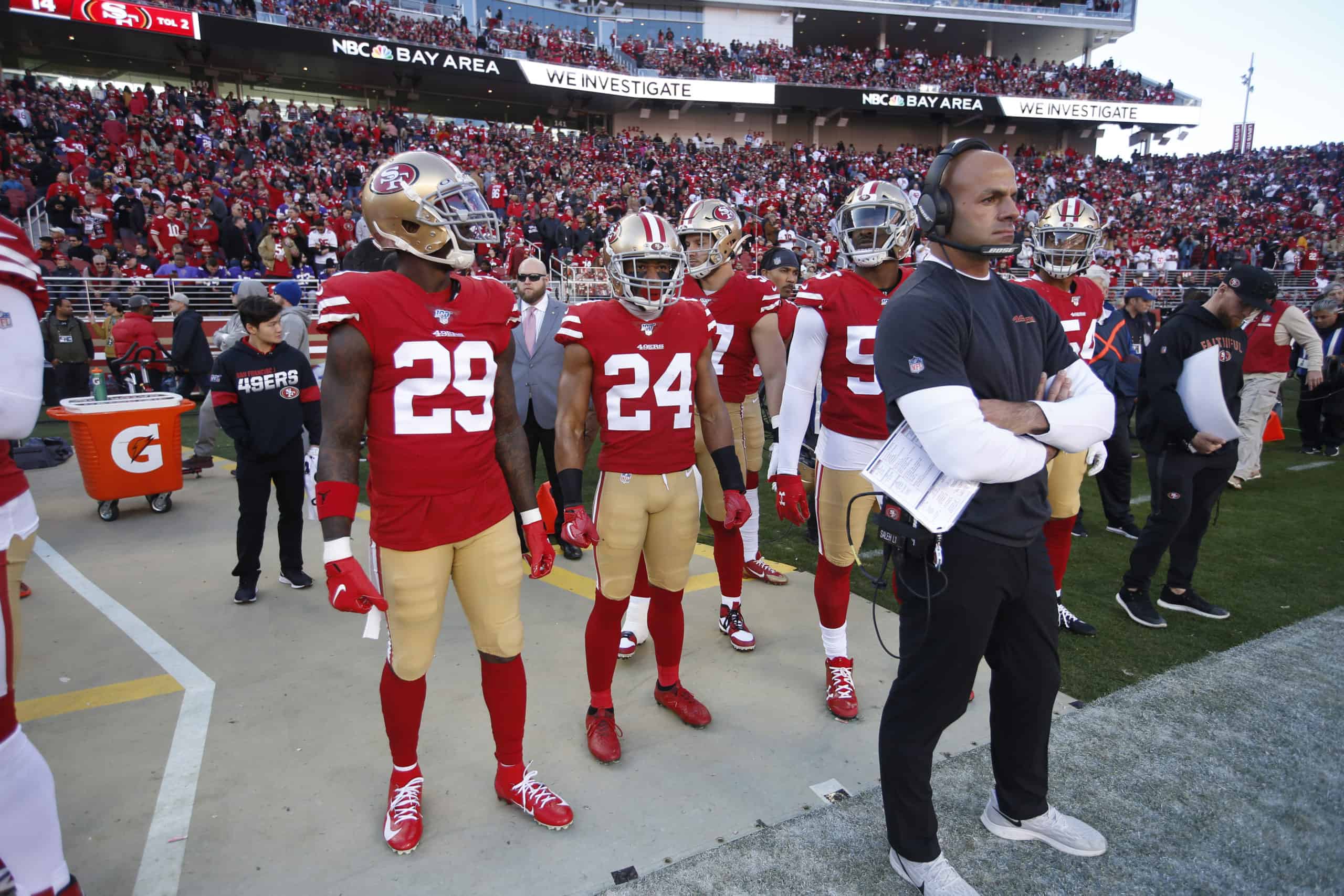The San Francisco 49ers are generally viewed as a Cover 3 team. That’s not inaccurate. Cover 3 was San Francisco’s most used coverage on opposing pass attempts in 2019. That “Cover 3” classification has come with a negative connotation, especially on individual players like Richard Sherman.
But the 49ers aren’t just spot dropping into zone coverage and hoping for the best. Defenses have evolved to match coverages and the San Francisco secondary has excelled at a combination of zone and man.
Even though the 49ers use Cover 3 most often, per Sports Info Solutions that rate was just on 31% of opposing pass attempts. So 69% of the time the 49ers are running something other than Cover 3. Earlier in the season, we discussed how NFL defenses were increasing the use of Cover 4 (or Quarters) and how the 49ers were leading the charge. That remained true throughout the regular season. San Francisco used Quarters on 21.6% of opposing pass attempts, their second-highest rate of coverage.
All of this has crept into the discussion of what the 49ers should do in the Super Bowl to defend against Patrick Mahomes and the Kansas City Chiefs. The answer might not really matter. The 49ers were among the league’s best defense in both of those coverages but the Chiefs were also the league’s offense attacking them.
In 2019, the 49ers allowed the third-lowest Expected Points Added per play in Cover 3, behind the Buffalo Bills and Pittsburgh Steelers, with the lowest yards per attempt allowed and second-lowest completion percentage.
49ers Cover 3, 2019
| Team | Comp% | YPA | EPA/Play |
|---|---|---|---|
| SF | 57.8% | 6.19 | -0.17 |
| NFL Avg. | 65.2% | 8.1 | .07 |
On offense, no team had more EPA per play than the Chiefs against Cover 3. During the regular season, there was a bigger EPA gap between the Chiefs and No. 2 New Orleans Saints than between the Saints and No. 10 Los Angeles Chargers.

San Francisco was just as good in Quarters. Only the Patriots allowed a lower EPA per play but the 49ers used the coverage significantly more. New England had just 26 opposing pass attempts in Quarters, while the 49ers saw 112, the second-highest number in the league. No team allowed fewer yards per attempt and only the Tampa Bay Buccaneers allowed a lower rate of plays that produced positive EPA.
Meanwhile, the Chiefs were an even better offense against Cover 4 in 2019. They also led the league in EPA per play against the coverage (0.51) and had a 60.7% positive play rate.

Of course, this matchup isn’t as easy as “should the 49ers play Cover 3 or 4? To stop the Chiefs” What made the 49ers so successful, especially in Quarters, was their ability to disguise the coverage before the snap. San Francisco had a number of Quarters snaps during the season that looked like they would be Cover 3 while the quarterback was doing his pre-snap work.
The Tennesse Titans tried a version of this against the Chiefs in the AFC Championship Game. They worked hard to disguise coverages but their added strategy of only rushing three defenders in front of the coverage ultimately backfired and made many of the disguises pointless, even with eight men in coverage. Mahomes had time in the pocket to either read what the defense was shifting into or he got to the point where he knew where a free rushing lane would be and that led to his big day on the ground.
San Francisco won’t have that problem. They reliably rush four and have succeeded in creating pressure with just the defensive line that it has allowed the secondary to move around. The 49ers’ back seven is also good enough it can feel like there are eight men in coverage.
It’s going to be hard to confuse Mahomes even with movement after the snap. The Chiefs’ offense is just as good at creating confusion before the snap with pre-snap motion. Kansas City used pre-snap motion at the fifth-highest rate in the league in 2019 (55%) and they use it in a way that can change the rules of coverage defenders and create one-on-one matchups where they shouldn’t be one.
On this play from Week 3 against the Baltimore Ravens, the Chiefs came out in a 3×1 set. On the trips side, Sammy Watkins motioned from the middle to the inside slot. Just that bit of movement caused the Ravens defenders to switch responsibilities and while a simple motion shouldn’t be enough to derail a defense, there was a mix up in communication for Baltimore and Mecole Hardman was free for an 83-yard touchdown.
Kansas City often uses its 3×1 looks to force mismatches in the secondary, often with Travis Kelce as the isolated receiver. They used it on Tyreek Hill’s second touchdown against the Titans. Motion from Hardman from the middle to inside slot showed man coverage and his post route forced the safety to stay in the middle of the field while Tennessee doubled Kelce on the other side. That left Hill one-on-one with cornerback Logan Ryan and it wasn’t hard for Hill to get behind him.
With motion, formations, and personnel, the Chiefs do an excellent job of manipulating coverage, no matter what the defense chooses to run. The 49ers have been the best at what they do on defense this season and the Chiefs have been the best at attacking those coverages. The chess match between those two sides and how they work to trick each other is just one of the many great matchups in this year’s Super Bowl.
















